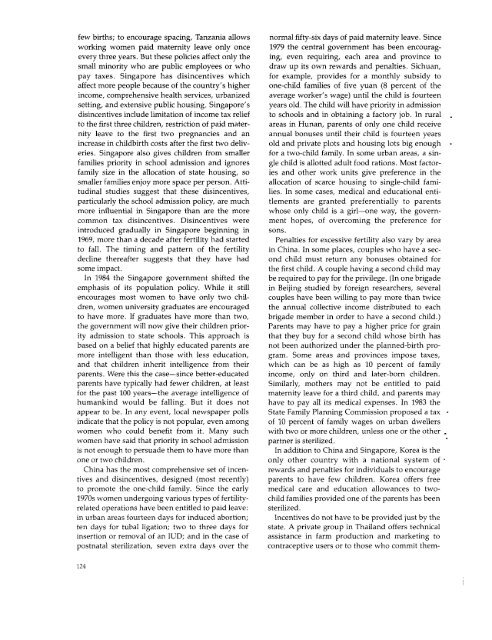World Development Report 1984
World Development Report 1984
World Development Report 1984
Create successful ePaper yourself
Turn your PDF publications into a flip-book with our unique Google optimized e-Paper software.
few births; to encourage spacing, Tanzania allows normal fifty-six days of paid maternity leave. Since<br />
working women paid maternity leave only once 1979 the central government has been encouragevery<br />
three years. But these policies affect only the ing, even requiring, each area and province to<br />
small minority who are public employees or who draw up its own rewards and penalties. Sichuan,<br />
pay taxes. Singapore has disincentives which for example, provides for a monthly subsidy to<br />
affect more people because of the country's higher one-child families of five yuan (8 percent of the<br />
income, comprehensive health services, urbanized average worker's wage) until the child is fourteen<br />
setting, and extensive public housing. Singapore's years old. The child will have priority in admission<br />
disincentives include limitation of income tax relief to schools and in obtaining a factory job. In rural<br />
to the first three children, restriction of paid mater- areas in Hunan, parents of only one child receive<br />
nity leave to the first two pregnancies and an annual bonuses until their child is fourteen years<br />
increase in childbirth costs after the first two deliv- old and private plots and housing lots big enough<br />
eries. Singapore also gives children from smaller for a two-child family. In some urban areas, a sinfamilies<br />
priority in school admission and ignores gle child is allotted adult food rations. Most factorfamily<br />
size in the allocation of state housing, so ies and other work units give preference in the<br />
smaller families enjoy more space per person. Atti- allocation of scarce housing to single-child famitudinal<br />
studies suggest that these disincentives, lies. In some cases, medical and educational entiparticularly<br />
the school admission policy, are much tlements are granted preferentially to parents<br />
more influential in Singapore than are the more whose only child is a girl-one way, the governcommon<br />
tax disincentives. Disincentives were ment hopes, of overcoming the preference for<br />
introduced gradually in Singapore beginning in sons.<br />
1969, more than a decade after fertility had started Penalties for excessive fertility also vary by area<br />
to fall. The timing and pattern of the fertility in China. In some places, couples who have a secdecline<br />
thereafter suggests that they have had ond child must return any bonuses obtained for<br />
some impact. the first child. A couple having a second child may<br />
In <strong>1984</strong> the Singapore government shifted the be required to pay for the privilege. (In one brigade<br />
emphasis of its population policy. While it still in Beijing studied by foreign researchers, several<br />
encourages most women to have only two chil- couples have been willing to pay more than twice<br />
dren, women university graduates are encouraged the annual collective income distributed to each<br />
to have more. If graduates have more than two, brigade member in order to have a second child.)<br />
the government will now give their children prior- Parents may have to pay a higher price for grain<br />
ity admission to state schools. This approach is that they buy for a second child whose birth has<br />
based on a belief that highly educated parents are not been authorized under the planned-birth promore<br />
intelligent than those with less education, gram. Some areas and provinces impose taxes,<br />
and that children inherit intelligence from their which can be as high as 10 percent of family<br />
parents. Were this the case-since better-educated income, only on third and later-born children.<br />
parents have typically had fewer children, at least Similarly, mothers may not be entitled to paid<br />
for the past 100 years-the average intelligence of maternity leave for a third child, and parents may<br />
humankind would be falling. But it does not have to pay all its medical expenses. In 1983 the<br />
appear to be. In any event, local newspaper polls State Family Planning Commission proposed a tax<br />
indicate that the policy is not popular, even among of 10 percent of family wages on urban dwellers<br />
women who could benefit from it. Many such with two or more children, unless one or the other<br />
women have said that priority in school admission partner is sterilized.<br />
is not enough to persuade them to have more than In addition to China and Singapore, Korea is the<br />
one or two children. only other country with a national system of -<br />
China has the most comprehensive set of incen- rewards and penalties for individuals to encourage<br />
tives and disincentives, designed (most recently) parents to have few children. Korea offers free<br />
to promote the one-child family. Since the early medical care and education allowances to two-<br />
1970s women undergoing various types of fertility- child families provided one of the parents has been<br />
related operations have been entitled to paid leave: sterilized.<br />
in urban areas fourteen days for induced abortion; Incentives do not have to be provided just by the<br />
ten days for tubal ligation; two to three days for state. A private group in Thailand offers technical<br />
insertion or removal of an IUD; and in the case of assistance in farm production and marketing to<br />
postnatal sterilization, seven extra days over the contraceptive users or to those who commit them-<br />
124









